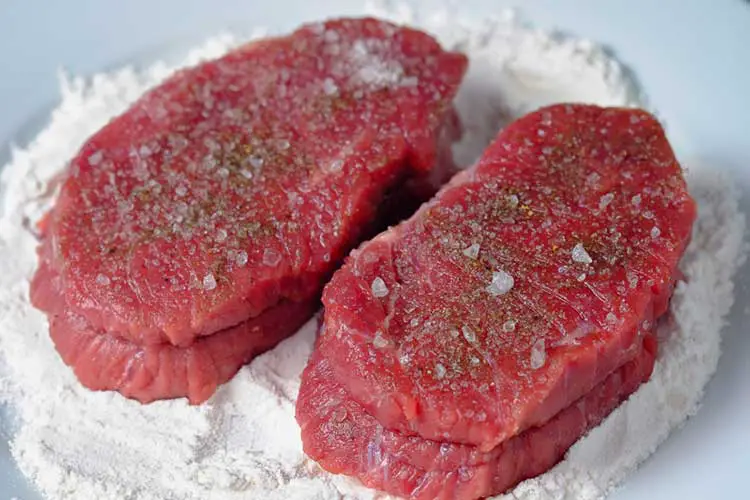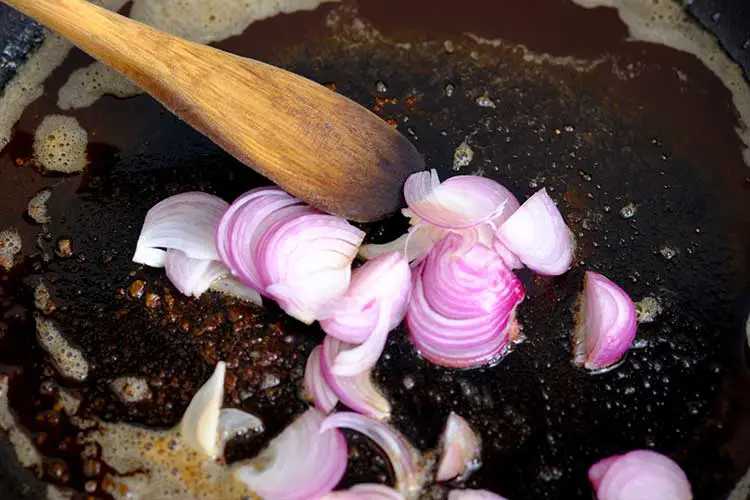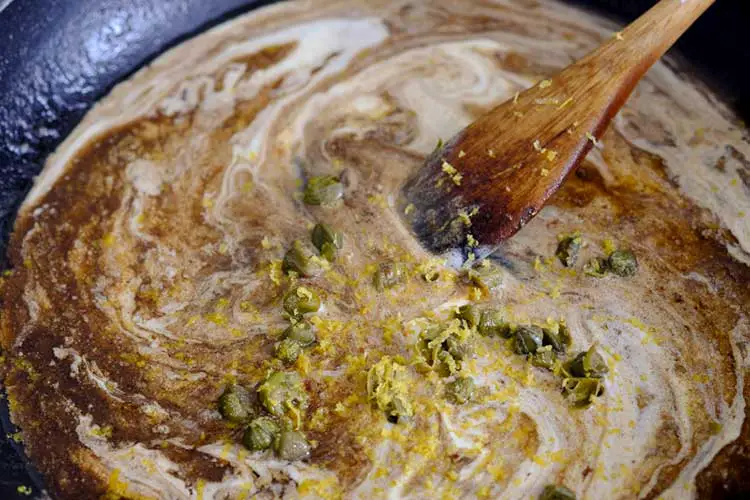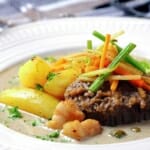Esterhazy Rostbraten – a braised beef sirloin in a rich creamy sauce – is a dish sent down to us mere mortals from the glory days of the Austro-Hungarian Empire. It was a time when a quality slab of meat was the height of dinner-time decadence and the family name Esterhazy was synonymous with luxury.
With all the elements of a top-notch Sunday roast – the beef, the potatoes, the root vegetables – Esterhazy Rostbraten has the added bonus of bathing its ingredients in a downright naughty sour cream sauce.
Forget schnitzels, here’s where the real juice of Austrian cooking lies.

KEEPING UP WITH THE ESTERHAZYS
The Esterhazys were a hugely rich and influential Austro-Hungarian dynasty whose legacy includes lavish palaces, classical music, fine wine and, well… beef.
Starting around the mid-16th century, the Esterhazy family’s fortunes went on the rise from their first decorated patriarch Ferenc Zerhazy, a deputy lord lieutenant turned Baron of Galantha, to the current Count of the family, Peter Esterhazy.
In the four centuries that separate the two men, the Esterhazys have been Palatines honored by the Holy Roman Empire, military men distinguished in battles against the Turks, and revered politicians. Rumored to have been wealthier than the Habsburgs, they, like the Medicis, were also great benefactors to the arts. Perhaps most notable of the latter was Prince Nikolaus I (1714-1790), who was a patron of the composer Haydn and for whom many of Haydn’s musical arrangements were written.
BURGENLAND’S SHIFTING SANDS
The Esterhazys eventually accrued over a dozen castles in central Europe, but it’s their enormous namesake palace in the Austrian town of Eisenstadt that was and remains their primary digs. It was Paul I (1635-1713) who was responsible for fixing up the family’s newly-acquired schloss in Eisenstadt into a state-of-the-art baroque mega-pad in 1663.
Today, Eisenstadt sits in a region called Burgenland. At the time of the palace’s renovations, Burgenland was in the Hungarian section of the Habsburg Empire, but it became part of Austria in 1921 after the dissolution of Austria-Hungary following the First World War. Remnants of Hungarian influence are still very much alive and kicking in Burgenland today, however. The local language is peppered with Hungarian terms, and there continue to be pockets of exclusively Hungarian-speaking folk in the region.
These moving borders account for the affinity, both culturally and – for the purpose of our interest here – culinarily, between the two neighboring countries.
There’s a great amount of similarity between Austrian and Hungarian national dishes, especially in stews and cakes. The Esterhazy Rostbraten, called Esterhazy Rostélyos on the other side of the border, is another one of these crossover dishes that began its life as Hungarian then found itself stranded in Austria when the borders changed: one of the less unfortunate consequences of World War I.
You May Also Like….
If you like hearty beef or steak meals like this, you might want to check out our recipe on a Uraguay sandwich – a yummy combination of ham and bacon and beef steak on a kaiser bread roll (chivito).
AN ESTERHAZY FOR EVERY MEAL
You can’t look at the sheer size and affluence of their Versailles-style castle in Eisenstadt without drooling at the thought of what would have gone down at the Esterhazys’ dinner table.
Going by the number of dishes named after the family today, we can assume they held some sway in culinary trends over the years too, with a namesake dish appearing in pretty much every food group: there’s Esterhazy cake (two varieties), Esterhazy goulash, Esterhazy schnitzel and Esterhazy Rostbraten (beef), all of which still hold a place on menus throughout Austria, along with some not-so-distant cousins in Hungary.
If the name Esterhazy rings a bell for you, it might also be because you’ve come across their wine brand. The family first started planting vineyards from the mid-18th century onwards on their land around Eisenstadt as the rolling landscape and well-watered valleys make it an excellent and fertile spot for wine-growing. Apparently Haydn – who was enamored with the region – had a part-cash, part-wine rewards scheme with his benefactors in return for his musical contributions.
NO TRUFFLES? NO PROBLEM
A couple of centuries ago, a prime cut of beef like the one recommended for Esterhazy Rostbraten would have been the kind of food item you got with your Christmas bonus if you’d scored a particularly good year. For the Esterhazys, however, it would have been an everyday feature of the food store, wedged between the boxes of Beluga Sturgeon caviar and the crates of white Tuscan truffles.
The apocryphal story of Esterhazy Rostbraten’s genesis reads like an episode of Downton Abbey: with only hours to go before dinner, the Esterhazy kitchen cooks realized they had emptied their last box of aforementioned white truffles (shriek!).
Forced to improvise an alternative, they came up with a preparation that involved grilling the meat and serving it in a sauce made with root vegetables and sour cream. The replacement was a smashing success that cozy winter evening and has stuck as a local staple ever since.
What was good enough for the Esterhazys soon became good enough for the rest of Austria and Hungary – who needs truffles when you have beef, root vegetables and sour cream?
ABOUT THE RECIPE
The first and most important part of getting Esterhazy Rostbraten right is getting the meat right.
The better, healthier, more organic and grass-fed the cow, the more delicious your steaks will be. Opt for a sirloin cut of about 180g per piece and don’t be afraid to discuss with your knowledgable butcher the details of the cut and what you’ll be needing it for.
The choice of cut is key: we have it on good (Austrian) authority that for a dish such as the Esterhazy Rostbraten, a cut from the rump, quite precisely somewhere near the 7th and 13th ribs, is the area you want to be shooting for. Look for finely divided fat, and when you slice the meat, be sure to leave the fat edge on as well. By the way, if you like this beef recipe you might like our other recipe on a steak, bacon and ham sandwich recipe.
If there is no string on the meat, or it breaks while you’re cutting it, do truss the steaks with some butcher’s twine so that they keep their shape while in the pan. Another good tip to stop the beef from contracting while frying is to cut into the meat a few times.
Season both sides of the beef cuts with salt and pepper and dredge one face of the steaks in flour. The flour does a number of things to the meat:
- It helps to seal in the moisture and flavor while frying
- It prevents the meat from sticking to the pan
- It adds a bit of flavor and crunch to the meat, which will be quite soft from the epic braising it’s going to get
- It also helps to thicken the sauce

Get your pan nice and hot with 2-3 tablespoons of butter. When it just starts to bubble, place your steaks – floured side down – into the hot butter. Use tongs so you can get a good grip on the sides of the meat. Sear the meat about 2 or 3 minutes on each side, then take it out and set it aside.

Keeping the oil from the beef inside the pan, fry up the shallots until they’re nicely brown. Feel free to add more butter at this stage. Don’t scrimp on the butter; love the butter. When they’re done, add some stock to the pan to deglaze it, giving the bottom a good rub with a wooden spoon. Let the liquid come to a simmer.

Now put the slices of beef back into the pan, floured side up, and add just enough stock to cover the beef about two-thirds to the top. Cover your pan and allow the meat to braise like this for about an hour, checking in every so often to see the level of the stock. You’ll probably need to top it up occasionally.
If you prefer, this stage of the braising can also be done in an oven. Make sure your covered dish is oven-proof, set your oven to 350ºF and leave it in there for an hour, still checking on the liquid levels once or twice.

With the meat braising, you can now start preparing the vegetables. Heat up the pan and start by throwing on the bacon. Fry it up until it renders off some of its fat.
Next, add the julienned vegetables and sauté briefly before adding a dash of beef stock and allowing the vegetables to soften in the steam until they’re ‘al dente.’ Be vigilant here – this process won’t take very long, and you don’t want to over-steam your veggies to a wilt.

Once the beef is done, take it out of the pan and set it aside, but keep the pan on the heat. You’re going to get ready for the sauce by mixing together the flour and sour cream and adding it to the remainder of the juices in the beef pan. Stir it in well till it’s nice and thick and smooth.
Continue by folding in the lemon zest and the capers and continue to reduce the sauce for another three minutes. If you really want to go Esterhazy on the sauce, throw in a few nuggets of butter towards the end to really enrich it. Like we said, you can never have too much butter.
Now put the beef slices back in the sauce and cover them completely so they can soak up all that creamy goodness.

To serve, place a beef slice onto a deep plate – floured side still facing up! – and ladle the sauce over the top and all around. Then heap the julienned vegetables over the meat and serve with a side of potatoes, fries or pasta.
Have the butler polish off your best silverware, stick Haydn’s Symphony #45 on the turntable and consume in your finest dining room.

OUR TAKE ON THE RECIPE
To us, our finished Esterhazy Rostbraten tasted like a creamy beef bourguignon: a strong beef flavor enriched with cream, but perfectly balanced by a subtle tang from the capers and lemon zest.
What we love about this recipe from our original reference is the deep flavor created from braising the beef, and the great thing about braising is that it’s a much more forgiving technique compared to grilling or quick stir-fries where doneness must be spot-on.
That said, we insisted on searing our meat prior to braising to seal more flavor into the meat and help develop the flavors of the overall Esterhazy Rostbraten. We also thought it would be better not to use non-stick cookware in order to allow for the formation of pan drippings that we could use in our sauce as well.
Also, we had a fun idea for the next time we cook an Esterhazy Rostbraten. We’re planning on preparing it sous-vide, which may seem off piste, but we’re betting the results will be excellent.
Finally, we concluded that the more fat and connective tissue on the meat (like from a shank or short rib cut), the richer the flavor would be. It’s something to keep in mind for your own preparation of the dish.
Guten Apetit!


Esterhazy Rostbraten
- Total Time: 45 minutes
Ingredients
- 4 slices Roast Beef or Beef Loin, each approx. 6 oz (180 g)
- 6 Shallots or 2 onions, cut into strips
- 1 small Carrot, julienned
- ½ root Parsley, julienned
- 1 small Turnip, julienned
- 1 small piece of Celery Root, julienned
- 1 teaspoon chopped Capers
- 1.7 oz Bacon, cubed
- 4 tablespoons Sour Cream
- ½–1 tablespoon Flour for the sauce + Flour for coating
- 13.5 liquid oz of Beef Stock or Water
- Lemon Zest
- Salt
- Pepper
- 2–3 tablespoons Butter
- Chopped Parsley for garnish
Instructions
Stage 1: Preparing Your Beef
- Cut the roast beef into inch-thick slices. If needed, truss each slice with butcher’s twine to help them retain their shape during braising.
- Season both sides of the beef generously with your salt and pepper.
- Next, dredge one side of your beef with flour.
Stage 2: Searing and Braising the Beef
- Heat your butter in a pan over high heat, then place your beef floured-side down into the pan and sear for 2-3 minutes.
- Flip your beef and sear that side for 2-3 minutes as well, then take out of the pan and set aside.
- Add in your shallots and lightly brown them in the same pan for 2-3 minutes, adding some more butter as needed.
- Deglaze the pan with your water or beef stock and reduce your stovetop heat to a simmer.
- Place the slices of beef back into the pan, add just enough stock to cover the beef 2/3 to the top.
- Cover your pan and braise the meat for about an hour or until tender. Check periodically on the level of your braising liquid, adding more stock or water as needed.
Stage 3: Sauteeing the Vegetables
- Put your pan over high heat and add your bacon, allowing it to render off some of its fat.
- As the fat renders, add in your chopped vegetables and sautee briefly for 3-4 minutes.
- Add a dash of beef stock, then let the vegetables steam until ‘al dente’ for another 6-10 minutes.
Stage 4: Finishing Touches
- Mix up a slurry of flour and sour cream into a bowl (make sure your mixture is clump-free)
- Once the beef has finished braising and is tender, take it out of the pan.
- Using the same pan the meat was cooked in, over low-medium heat, pour in the flour/sour cream mixture, stirring continuously for 1-2 minutes until it’s thick and smooth.
- Fold in your capers and lemon zest, then allow the sauce to reduce for another 3 minutes.
- Next, put your Esterhazy Rostbraten back into the pan coating it evenly with the sauce.
- When plating, arrange the beef slices on a plate and garnish with the sauteed root vegetables, some sauce and fresh chopped parsley. Serve with pasta or fried potatoes, and enjoy!
Notes
- Braising can be done on the stove or in an oven set to 350F (180C).
- The sauce may further be refined by whisking in a few cold butter nuggets.
- Beef shanks or short ribs would be excellent choice cuts for Esterhazy Rostbraten.
- Prep Time: 15 min
- Cook Time: 30 min

